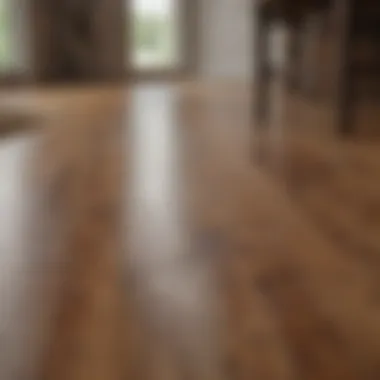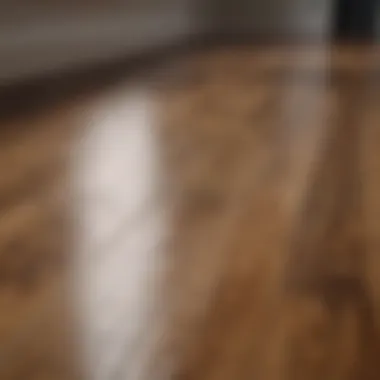Cleaning Hardwood Floors with White Vinegar: A Guide


Intro
Cleaning hardwood floors often poses challenges for homeowners. They must find effective methods that do not damage the wood while ensuring thorough cleanliness. This article focuses on one popular option: white vinegar. Given its accessibility and natural cleaning properties, white vinegar has become a favored choice in many households. Exploring its efficacy as a cleaning agent is essential for those who wish to maintain the beauty and longevity of their hardwood floors.
White vinegar's chemical composition enables it to cut through grime and eliminate odors, making it a compelling choice. However, understanding both the advantages and potential drawbacks is crucial. This understanding allows homeowners to make informed decisions about their cleaning methods—balancing effectiveness with safety for their hardwood surfaces.
In the following sections, we will discuss how to utilize white vinegar effectively, compare it to other products, and cover safety considerations in cleaning.
Feature Spotlight
In the realm of floor care, white vinegar stands out for its simplicity and efficacy.
Unique Cleaning Properties
White vinegar is primarily acetic acid, which allows it to break down build-up and eliminate bacteria. Its non-toxic nature is beneficial for both the user and the environment. Unlike many harsh commercial cleaners, vinegar does not emit harmful fumes. Users looking for a cleaner solution appreciate that it won’t contribute to indoor air pollution.
The following key features highlight white vinegar's unique advantages:
- Natural Antimicrobial Properties: The acidity in white vinegar inhibits the growth of certain bacteria.
- Versatile Application: It can be used for more than just floors; it works on windows, countertops, and other surfaces.
- Cost-Effective: Generally, vinegar is cheaper than many specialized cleaning products available in stores.
While its benefits are notable, some precautions must be taken.
Considerations for Use
Overuse of vinegar can harm certain hardwood finishes. Diluting it with water is advisable to prevent damage. Testing on a small, inconspicuous area should precede any cleaning actions.
"White vinegar is a powerful tool when used correctly, but it can also cause harm if applied improperly."
How to Clean Hardwood Floors with White Vinegar
To maximize the benefits of white vinegar for your hardwood floors, it is essential to follow a systematic approach. Here’s a step-by-step guide:
- Prepare the Mixture: Combine one part white vinegar with three parts water in a bucket. This dilution helps prevent any adverse effects on the wood finish.
- Sweep or Vacuum: Before mopping, remove any dust, dirt, or debris that can scratch the surface.
- Mop the Floor: Use a soft mop or cloth to clean the floors. Wring out excess liquid to avoid over-saturating the floor.
- Dry the Surface: Ensure the floors dry adequately to prevent moisture damage.
- Repeat Regularly: Establishing a regular cleaning routine can help maintain the pristine condition of your hardwood floors.
As you continue cleaning, observe how your floors react. Understand that consistent care contributes significantly to longevity.
Closure
In summary, white vinegar presents an effective solution for cleaning hardwood floors while being environmentally friendly and economical. By understanding its strengths and limitations, homeowners can preserve their hardwood investments with confidence.
Careful application combined with thorough knowledge ensures the efficient maintenance of hardwood floors, making white vinegar a suitable cleaning alternative for many.
Prelims to Hardwood Floor Care
Hardwood floors are a significant investment in any home. Understanding how to properly care for them is crucial for preserving their beauty and longevity. This article aims to explore effective cleaning methods, particularly focusing on the use of white vinegar. It will address both the practical and theoretical aspects of hardwood floor maintenance.
Understanding Hardwood Floors
Hardwood floors are made from solid wood and are known for their durability and aesthetic appeal. They add value to a property and create a warm, inviting atmosphere. Different types of wood, such as oak, maple, or cherry, provide distinct looks and characteristics. Each type must be treated with care and tailored cleaning methods to maintain its unique properties. Knowing the specific kind of hardwood flooring can inform the cleaning process, making it more effective and safer.
Regular inspection of hardwood floors for scratches or dents is vital. These surfaces begin to lose their shine over time. Dust and dirt can accumulate, leading to scratches if not dealt with promptly. A better understanding of hardwood types and finishes is necessary for effective cleaning. For instance, a glossy finish may require different care routines than a matte one. Knowing these details can help homeowners choose the right cleaning products.
Importance of Regular Cleaning
Regular cleaning of hardwood floors is not just a matter of aesthetics. It serves several critical purposes:
- Prevention of Damage: Dirt and debris can act like sandpaper when walked on, potentially scratching the hardwood surface.
- Allergen Control: Dust mites, pet dander, and other allergens can build up on floors. Regular cleaning can help reduce these health risks.
- Long-term Value: Maintaining the floors can prolong their life, ultimately saving homeowners money on repairs or replacements.
- Visual Appeal: Consistent cleaning keeps floors looking polished, enhancing the overall look of the home.
In summary, understanding and caring for hardwood floors can have lasting benefits. Regular cleaning routines ensure the floors remain beautiful and functional for many years.


White Vinegar as a Cleaning Agent
White vinegar serves as an effective cleaning agent, especially for hardwood floors. Its wide-ranging benefits stem from its natural, non-toxic properties and the ability to tackle common cleaning challenges. Homeowners often seek alternatives to commercial cleaners, and white vinegar stands out due to its effectiveness and cost efficiency. This section explores the chemical composition of white vinegar and its cleaning capabilities, including how it disinfects surfaces and removes stains.
Chemical Composition of White Vinegar
White vinegar primarily contains acetic acid, which contributes to its cleaning power. Typically, white vinegar is comprised of about 5-7% acetic acid and 93-95% water. This acid is effective at breaking down dirt and grime, making it suitable for various household cleaning tasks. Its low pH level creates an environment that is hostile to many bacteria and molds. Thus, its composition positions it as a versatile cleaning agent. Homeowners appreciate its efficacy without the harsh chemicals often found in commercial products.
How Vinegar Cleans
White vinegar cleans through several mechanisms, making it a valuable choice for maintaining hardwood floors. Its effectiveness relies on its disinfecting properties and its capacity for stain removal, both of which are notable aspects.
Disinfecting Properties
The disinfecting properties of white vinegar stem from its acetic acid content. This acid can kill many types of germs and fungi, thus reducing the risk of illness in a household. The major advantage of using vinegar for disinfecting is that it doesn’t leave harmful residues often found in chemical cleaners. White vinegar is widely recognized for being a safe alternative, especially for homes with children and pets. However, it is important to note that while vinegar is effective against many bacteria, it may not eliminate all pathogens that commercial disinfectants do. This is a critical consideration for those prioritizing sterilization.
Stain Removal Mechanism
The stain removal mechanism of white vinegar also plays a significant role in its cleaning properties. The acetic acid in vinegar cuts through various stains by breaking down the compounds that hold them to surfaces. This feature makes it effective for dealing with common hardwood floor stains, such as spills from juice or food. In addition, white vinegar can help to neutralize odors trapped in the materials. However, caution must be exercised with certain finishes on hardwood flooring. Prolonged exposure to vinegar may damage some finishes, so testing in a small area is advisable before widespread application.
In summary, white vinegar is not only a cleaning agent but a multifaceted solution for hardwood floor maintenance. Its natural composition and dual action as a disinfectant and stain remover highlight its utility in everyday cleaning.
Methods of Cleaning Hardwood Floors with White Vinegar
Cleaning hardwood floors with white vinegar requires proper techniques to ensure the yield of good results. This section discusses various methods focusing on how to prepare, apply, and finish the cleaning process effectively. Understanding these methods helps homeowners maintain their hardwood floors to preserve their aesthetics and structural integrity.
Preparing the Cleaning Solution
Recommended Ratios of Vinegar to Water
To create an effective cleaning solution, the right ratio of vinegar to water is pivotal. A typical recommendation is mixing one cup of white vinegar with one gallon of warm water. This ratio works well because it balances cleaning strength with safety for the wood finish. Using too much vinegar may lead to stronger odors and potential damage to the wood finish, while too little may not yield sufficient cleaning power. Thus, the vinegar-water mix is both simple and effective.
Optional Additives for Enhanced Cleaning
In addition to vinegar, some homeowners consider adding other substances to increase cleaning efficacy. For example, a few drops of dish soap can improve grease removal, while essential oils like tea tree or lavender can reduce odors and enhance the scent of the mixture. However, caution is advised when using additives. Some may leave residues that could stick to the floor or might interact negatively with the wood’s finish. Therefore, keep the mixture simple, allowing vinegar to maintain its cleaning properties while minimizing unintended consequences.
Application Techniques
When applying the cleaning solution, it is important to use a gentle approach. A microfiber mop is advisable as it holds moisture well without soaking wooden floors excessively. Start at one corner of the room and work systematically to cover the entire area. Always avoid puddling or letting the solution sit on the wood, as this can damage the finish over time. Instead, dampen the mop well and wring it out before contact with the floors.
Drying and Finishing Methodologies
After cleaning, ensure your hardwood floors dry quickly to avoid moisture damage. Open windows for ventilation or turn on overhead fans to expedite the drying process. In some cases, a dry, clean microfiber cloth can be used to buff the surface once it dries. This not only aids in drying but also gives the floor a nice sheen.
Cleaning hardwood floors with white vinegar is an effective and eco-friendly approach to maintenance when done correctly. The preparation, application, and finishing steps ensure that the floors not only look exceptional but are also maintained over time.
Advantages of Using White Vinegar
The use of white vinegar for cleaning hardwood floors brings several advantages that merit close attention. Understanding these benefits can help homeowners make informed choices about their cleaning methods. This section will explore the natural and non-toxic nature of white vinegar, as well as its cost-effectiveness in comparison to other cleaning solutions.
Natural and Non-Toxic
White vinegar is a popular choice among eco-conscious individuals. It is a natural product that does not contain harsh chemicals often found in commercial cleaners. This quality makes it a safer option for households with children or pets. Using white vinegar means reducing chemical exposure in the home environment.
Furthermore, the pH level of vinegar is slightly acidic, which allows it to break down dirt and grime without damaging the hardwood surface. Because it is biodegradable, it does not contribute to environmental pollution when disposed of. Many people appreciate this environmentally friendly aspect, as it aligns with their values regarding sustainability.
Cost Effectiveness
Another significant advantage of using white vinegar is its affordability. Compared to specialty cleaners priced at high margins, white vinegar is a budget-friendly option. A large jug of white vinegar can often be purchased for a modest sum, and a small amount is sufficient for most cleaning tasks. This cost efficiency can be particularly beneficial for homeowners who regularly maintain their hardwood floors.


In addition to the low price, using vinegar allows individuals to avoid purchasing multiple cleaners designed for different surface types, thus reducing overall expenses.
"Choosing white vinegar not only protects your budget but also supports a healthier home environment."
The practical benefits of using white vinegar as a cleaning solution are clear. It serves as an effective, safe, and economical choice for maintaining the beauty and integrity of hardwood floors.
Potential Disadvantages
Understanding the potential disadvantages of using white vinegar for cleaning hardwood floors is crucial. While vinegar presents itself as a cost-effective and natural solution, certain drawbacks may arise during its application. This section will explore specific concerns related to its impact on various finishes and the sensory experience during use.
Risk of Damage to Certain Finishes
Not all hardwood finishes are created equal. Some are more delicate and susceptible to chemicals than others. White vinegar can be acidic, which means that prolonged exposure can cause harm, particularly to finishes like polyurethane. These coatings provide a protective barrier and enhance the wood's appearance. When vinegar interacts with these finishes, it may lead to dulling, discoloration, or even degradation over time.
To minimize the risk of damage, homeowners should consider the following:
- Test a small area first: Apply the vinegar solution in an inconspicuous spot and wait for a few hours to see how the finish reacts.
- Use appropriate dilution: A common recommendation is mixing one part vinegar with ten parts water. This reduces acidity and lowers the risk of potential damage.
- Avoid frequent use: Limiting the cleaning frequency to once a month, or as needed, can help mitigate adverse effects.
Odor Considerations During Use
While white vinegar is heralded for its cleaning prowess, the associated smell may not be pleasant for everyone. During application, the pungent odor can linger, potentially causing discomfort in living spaces. This odor typically dissipates after a while, but for those sensitive to smells, it might be bothersome.
To address this concern, consider the following strategies:
- Ventilate the area: Open windows or use fans to help dissipate the odor more quickly.
- Add essential oils: Integrating a few drops of essential oils such as lavender or lemon can mitigate the strong vinegar scent. However, ensure that these additions do not react negatively with the cleaning solution.
- Use when away from home: Scheduling cleaning sessions when no one is home can also help avoid exposure to the smell.
It's essential to weigh the benefits against these potential disadvantages when choosing to clean hardwood floors with white vinegar. Consider your specific flooring type and personal tolerance for odors in the decision-making process.
Safety Precautions
Understanding the safety precautions when cleaning hardwood floors with white vinegar is essential for both effective cleaning and preserving the integrity of the flooring material. While white vinegar is a natural cleaning agent, its misuse can lead to unsightly damage or degradation over time. This section addresses crucial safety guidelines to ensure optimal results without compromising the quality of the hardwood.
Dilution Guidelines
The first step in ensuring safety is adhering to proper dilution guidelines. White vinegar is acetic acid, and using it in concentrated form might harm some finishes on hardwood. Experts recommend a safe dilution ratio typically consists of one part white vinegar to four parts water. This mix creates a gentle solution that effectively cleans while minimizing risks of finish damage.
To prepare the solution:
- Measure out one cup of white vinegar.
- Add four cups of water to the same container.
- Mix thoroughly before applying to the floor.
Using hot water can help enhance the vinegar's cleaning effect but be cautious to let it cool slightly before application. Always avoid using boiling water as it may pose a risk both to your hands and the wood floor finish.
Test Areas for Compatibility
Before applying the vinegar solution across the entire floor, testing is crucial. Different hardwood finishes, like polyurethane or oil-based finishes, react uniquely to vinegar. Selecting a small inconspicuous area of the floor to test is advisable. Apply the diluted solution with a clean cloth and observe any immediate reactions.
Steps for testing:
- Choose a hidden spot near walls or under furniture for a discreet test.
- Use a cloth to apply a small amount of the vinegar solution.
- Wait for a few minutes to observe any changes in the finish or color.
If the test area shows signs of dullness or discoloration, discontinue use and consider alternative cleaning supplies. If the finish remains intact, it suggests that your floor can tolerate the vinegar solution safely.
It's wise to remember that taking these safety precautions will not only protect your hardwood but also extend its lifespan, making your investment worthwhile.
Long-Term Maintenance of Hardwood Floors
Maintaining hardwood floors requires a thoughtful approach over time to ensure they retain their beauty and durability. The benefits of long-term maintenance are significant. It can save homeowners from costly repairs and refinishing in the future. Regular upkeep helps to keep surfaces clean and free from dirt and debris, which if left unchecked, can lead to scratches and damage.
Alternative Cleaning Solutions


Commercial Cleaners
Commercial cleaners are widely available, and they offer specific formulations tailored for hardwood. These products are designed to clean without leaving residue, which is a common challenge with lesser solutions. Many brands, like Bona Hardwood Floor Cleaner and Murphy Oil Soap, provide effective results, making them popular among homeowners.
These cleaners often have a specific characteristic; they are engineered for ease of use. Homeowners appreciate that they can apply these cleaners directly to the floor without needing to mix or dilute. However, one must be cautious. While commercial cleaners can be effective, some may contain chemicals that are harmful to the environment or not safe for frequent use. This is an aspect to consider, especially in homes with pets or children.
DIY Mixtures
DIY mixtures, such as those made from white vinegar and water, are gaining popularity. These solutions are economical and allow for customization, fitting individual needs and preferences. They are popular for their accessibility and the fact that most ingredients can be found at home.
The key characteristic of DIY mixtures is their natural components, which often appeal to environmentally conscious consumers. However, the challenge with DIY cleaners can be consistency in efficacy. Some mixtures may work well on certain stains but not on others. Homeowners should be mindful to test any new solution in an inconspicuous area before full application to avoid unintended damage.
Preventative Measures to Preserve Wood
Using Mats and Rugs
Using mats and rugs is a simple yet effective method to preserve hardwood floors. These items catch dirt and moisture, reducing the wear on the wood surface. It is beneficial to place mats in high-traffic areas, such as entryways and kitchens.
Another advantage of using mats is the variety of styles available. Homeowners can select options that complement their decor while providing protection. This dual functionality appeals to many, making mats an ideal choice for long-term maintenance. The downside is that mats require regular cleaning or replacement to remain effective; otherwise, they can become a source of dirt themselves.
Proper Footwear on Hardwood
The type of footwear worn on hardwood floors has a direct impact on their maintenance. Soft-soled shoes tend to be less damaging compared to hard-soled varieties. Encouraging family members and guests to wear appropriate footwear can significantly reduce scratches and gouges over time.
This practice is not only beneficial but can also create a consistent experience within the home. It enhances comfort and protection. However, it may require reminders or signs in certain areas to ensure compliance. Understanding the correlation between footwear and floor longevity is essential for sustainable floor upkeep.
The importance of long-term maintenance cannot be overstated; it directly impacts the aesthetic and functional lifespan of hardwood floors. Regular attention to cleaning and preventative measures sets the stage for classic beauty to endure.
Environmental Considerations
The cleaning methods we choose not only impact our living spaces but also influence the environment. Using white vinegar as a cleaning solution presents significant environmental considerations worth evaluating. This section highlights the importance of selecting eco-friendly cleaning products, emphasizing sustainability, and understanding how our choices can affect the planet.
Biodegradability of Vinegar
White vinegar is a product known for its biodegradability. This means it can break down naturally without causing harm to the environment. Unlike many commercial cleaners that contain harsh chemicals, vinegar does not linger in ecosystems or contribute to pollution.
Additionally, according to research, a product's biodegradability reduces the environmental footprint benefit. Using white vinegar helps lower the risk associated with chemical runoff that can affect water systems. It mineralizes into harmless components, making it a safe choice for cleaning surfaces at home.
Comparative Impact of Cleaning Products
When evaluating different cleaning options for hardwood floors, it's essential to compare their environmental impact. Many common commercial cleaners contain toxic ingredients that can release volatile organic compounds (VOCs). These pollutants can contribute to air quality issues and pose serious health risks to individuals exposed to them regularly.
In contrast, white vinegar poses minimal risks associated with chemical exposure. Here’s why:
- Natural Ingredients: White vinegar consists mostly of acetic acid and water, which are naturally occurring substances. It lacks synthetic additives and fragrances, making it safer for indoor use.
- Reduced Chemical Waste: By choosing vinegar, you effectively minimize plastic waste often produced by bottled commercial cleaners.
"Opting for vinegar not only enhances the cleanliness of your floors but also embraces a more sustainable lifestyle."
- Lower Environmental Cost: The cleaner is often less expensive and accessible, reducing the demand for manufactured products that carry higher environmental costs far beyond their price.
The End
In this article, we explored the efficacy of using white vinegar as a cleaning solution for hardwood floors. Understanding the cleaning properties of white vinegar helps homeowners make informed choices. The discussion outlined the various benefits of this natural cleaning agent, including its effectiveness against common household stains and its non-toxic nature.
Final Thoughts on Vinegar Use
White vinegar serves as a practical alternative to conventional cleaning products. Its chemical properties allow it to effectively break down dirt and disinfect surfaces. However, consideration should be given to specific hardwood finishes. Some finishes may react negatively to vinegar, leading to potential damage. Always assess the compatibility with your floor type before applying any cleaning solution.
Recommendations for Homeowners
For homeowners seeking to maintain their hardwood floors effectively, a few key recommendations emerge:
- Always dilute the vinegar: Use a solution with a ratio of one cup of white vinegar to one gallon of water. This dilution enhances cleaning efficacy while minimizing any potential harm to the finish.
- Conduct a patch test: Apply the vinegar solution to a small, inconspicuous area of the floor to ensure its compatibility.
- Using the right tools: Opt for a microfiber mop that is gentle on your floor. Avoid using excessive water, as standing water can damage hardwood.
- Regular maintenance: Establish a cleaning schedule that incorporates vinegar cleaning every few weeks. This keeps your hardwood floors looking pristine.
By following these practices, homeowners can enjoy the benefits of a cleaner environment while ensuring the longevity of their hardwood floors.







